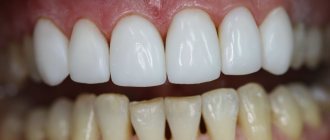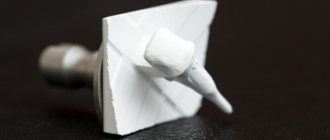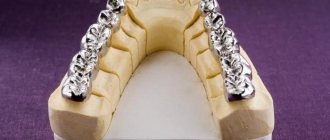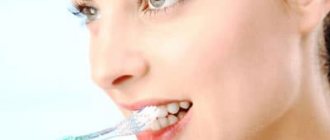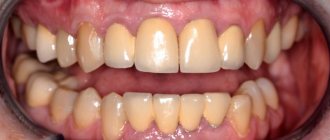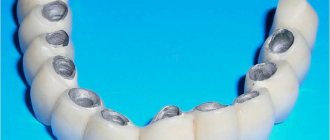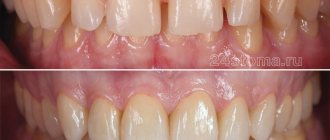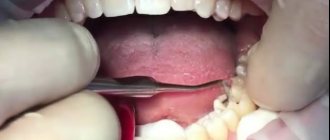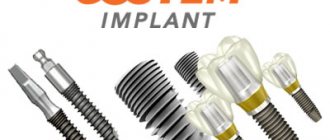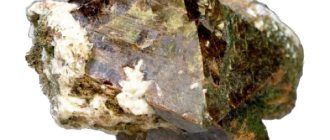Dental restoration of the dentition involves not only returning the functionality of the jaw, but also the formation of an aesthetically attractive smile. This aspect becomes especially important when restoring anterior units, for which the installation of implants is recommended. One of the significant elements that influences aesthetics is the connection between the pin and the artificial crown - the abutment - for the manufacture of which it is recommended to choose zirconium dioxide.
Advantages and disadvantages
Advantages:
- high biocompatibility of the material - does not cause allergic reactions, reduces the period of adaptation of soft tissues;
- its optical properties are close to natural teeth - it has the same color, transparency, and reflective ability;
- the smooth surface prevents the accumulation of bacterial plaque;
- supports soft tissues well, forms the correct gum contour;
- minimizes the risk of cement leakage under the gum;
- durability.
Flaws:
- the palette includes only two shade options: bright white, dark yellow;
- high cost of all-milled models.
Selection of abutments when installing zirconium dioxide crowns
Zirconium crowns are universal - they can be used with a titanium post and abutment, but from an aesthetic point of view, the best choice would be an all-zirconium design or at least a zirconium abutment.
The metal abutment is good for its strength, but the aesthetic defect can be the same as when installing metal-ceramics - the titanium part of the prosthesis through the gum and the metal abutment through the crown. Therefore, it is better to install a zirconium abutment for the front teeth - in this case, the dentures will be indistinguishable from natural teeth.
What types are used for dental implantation?
- Standard - since personal parameters are not observed during production, the structures are not able to replicate the shape of the tooth and gums, which sometimes reveals their artificial origin.
- Individual - made from personal impressions. In this case, the anatomy of the patient’s dentofacial apparatus is taken into account to ensure a tight fit to the elements of the implantation system and gum tissue.
Standard models of zirconium abutments, manufacturers
- Nobel Biocare (Switzerland) is the main manufacturer of dental implants and components. The catalog includes superstructures made of titanium, zirconium and gold alloys.
- Astra Tech (Sweden) - creates corner and straight models using its own developed technologies. The products are perfectly combined with crowns made of any materials.
- Xive (Germany) - offers abutments made of biocompatible materials.
- Osstem (South Korea) - produces implants, superstructures and surgical instruments .
- Ankylos is a German manufacturer that produces straight and angled zirconium abutments.
- Alpha Bio is an Israeli company. The line contains a wide selection of suprastructures made of titanium and thermoplastic polymer with different methods of fixation. Zirconium is presented in a straight configuration.
- Mis is an Israeli company whose catalog includes connecting elements with a standard platform and with the possibility of switching.
Custom zirconia abutment: manufacturing and fixation
Zirconium is not noticeable under a ceramic crown, is resistant to chewing loads, and does not change its original properties throughout its service life. The material is compatible with CAD/CAM computer modeling .
Stages of installing an individual connecting element:
- After inserting the implant and attaching the plug, impressions are taken from the jaw.
- The manufactured model is scanned and transferred to the modeling program.
- An abutment is cut out from a single piece of zirconium dioxide using a computerized machine using CAD/CAM technology.
- The finished structure is fixed to the implant with cement or a screw.
»
General overview
The functionality of the abutment provides for the possibility of using the product not only as a connecting link between the implant and the crown, but also as a support on which permanent prosthetic structures are fixed. Modern manufacturers offer models of different shapes and types, each of which is designed to solve a specific range of problems.
The standard classification provides for the division into template and individual types of abutments - in the first case we are talking about universal standard designs, in the second - about products made on the basis of an impression reflecting the features of the anatomical structure of the patient’s jaw. In addition, among the existing varieties, the following configurations are distinguished:
- Direct – practical to use, and recommended when implementing the classic two-stage prosthetic protocol;
- Standard – connecting elements, presented in six variations, a set of which allows you to choose the best option for any clinical picture;
- Angled – allow adjustment of the tilt of the clamp, so the doctor can change the position of the system and fix it in its natural position;
- Ball-shaped – used when installing removable prosthetic structures;
- Temporary - also known as gum formers, designed primarily to protect the system from the penetration of food particles and pathogenic microbes that can provoke the development of inflammatory processes.
The choice of model is determined by the specific anatomical structure of the dentition, as well as medical recommendations, on the basis of which a prosthetic plan is formed.
Which is better: titanium, gold or zirconium
Characteristics of structures depending on the material:
- Titanium - titanium copes well with chewing loads, however, the aesthetics of the restoration will be far from natural, since the material tends to show through the crown.
- Gold Ceramic-On is an alloy with a high gold content of 98%. The finished structure is covered with ceramic mass containing natural minerals, which gives the restoration excellent aesthetics.
- Titanium with cemented zirconia part . The frame of the structure is made of titanium and bonded to an individual zirconium component. The ability to correct the structure and color of the secondary component allows you to achieve high attractiveness when replacing teeth.
- Full zirconium . Made from a monolithic block of zirconium dioxide. Does not cause allergic reactions. Thanks to the color of the material, which is close to the natural shade of the teeth, it does not show through the crown.
- resin abutments . They are used for restoration of the smile area with temporary cement-fixed structures. They can be installed for up to 6 months during implantation treatment.
Titanium can be seen through the gum, so titanium components are primarily used in masticatory restorations. For the frontal area, it is better to use abutments made of materials whose color matches the natural color of the teeth.
Complaints about decementing of the old maxillary bridge on the left
Before
Stages
After
Specialists:
Kyalov Grigory Georgievich
Description:
When contacting our clinic, this patient complained of decementing of the old maxillary bridge on the left. Because of this, his quality of chewing food deteriorated. The patient had difficulty smiling.
After a comprehensive diagnosis of the dentition and jaws, the patient was offered the installation of dental implants in place of the destroyed teeth. And also, carry out total functional and aesthetic rehabilitation, taking into account the presence of severe abrasion of the remaining teeth and multiple abfractions (non-carious lesions). At the time of dental implantation, a temporary crown was immediately installed in our clinic (with immediate loading on the dental implants). This allowed the patient to continue effective work activities because the missing teeth were in the smile zone. After the implantation of dental implants, we proposed a scheme for functional and aesthetic rehabilitation of the dentition, which was successfully implemented with separate ceramic restorations and veneers.
Screw fixation of crowns to implants.
- There is always a hole on the crown that has to be closed with composite. Aesthetics suffer from this. In addition, the hole of the screw shaft may be located on the tubercle, the cutting edge (in these areas frequent chipping of the composite covering the “hole” is possible) or the front surface of the front teeth (in this case there will be a clear failure in aesthetics).
- With long bridges supported by implants, even with small inaccuracies in the frames (which happens quite often in our lives), screw fixation can give the doctor a false sense of confidence that everything fits “as it should, without gaps.” In fact, by “pulling” the frame of the crowns to the implants, the doctor concentrates a lot of stress on the fixing screws and then unpleasant problems are possible. For example, a screw may simply burst. And then getting it out of the implant is a big problem. All this can end quite sadly, up to the need to remove the “screw” with a piece of the fixing screw inside.
In this diagram: 1-implant, 2-abutment/crown, 3-fixing screw. The red arrow shows the location of the fixing screw inside the implant during screw fixation. Blue - possible fracture of the screw when tightening an inaccurately manufactured structure and, as a result, excessive stress is concentrated on the screw.
Cement fixation of crowns to implants.
1. One of the main disadvantages is that excess cement squeezed out when fixing the crown can form a thin film quite deep between the gum and the abutment. And this is one of the possible reasons for the development of peri-implantitis - inflammation of the bone tissue around the implant. Once this process starts, it is not so easy to stop it, and it can all end in the loss of the implant. And along with it, bone tissue to replace it with a new one.
This photo shows a crown cemented onto an abutment. The arrow shows a film of hardened cement, which can cause inflammation around the implant - peri-implantitis.
2. If the fit of the crown frame to the abutment is not very precise, the fixing cement may be washed away by saliva over time. The resulting gap will begin to be filled with soft plaque and oral bacteria. At best, this will end in easily correctable decementation and loss of the crown. In the worst case, again, there is a basis for the development of priimplantitis.
The arrows indicate the gaps between the crown and the abutment. If such a crown is cemented, after some time these cracks will become a storage area for soft plaque.
In fact, all the indicated disadvantages of both methods are easy for a knowledgeable doctor to circumvent. So let’s hope that you will get just such an orthopedist, and you will not have a headache on such a specific issue as choosing a method for fixing a crown to an implant.
Is it possible to put bridges on implants?
Yes. This happens all the time. Not always from a good life, but still there is nothing terrible in this design on implants. In some cases, this may even be a better option than sticking “screws” into each missing tooth. Moreover, in some situations it is quite possible to do the so-called on implants. consoles - i.e. suspended teeth with support on only one side. This is something that is strictly undesirable to do on our natural teeth, but under certain conditions it can be done on implants. But, of course, this does not mean at all that if all the teeth on the jaw are missing, you can put a couple of implants on the edges and build a bridge “from ear to ear” of 14 units on them.
Here I will make a small digression about toothless jaws. If we are talking about prosthetics on implants with fixed bridges for a jaw that is already “bald”, like a knee, then the minimum requirement is to install at least 6 supporting implants. Better yet, 8 or even 10. The more supports, the less vulnerable the structure will be over time and easier to maintain, both for you and for the dentist. Say, with 8 or 10 supports, a large single bridge for the entire jaw can be divided into several (2 or 3) separate ones. This will have the advantage of facilitating hygiene procedures and easier subsequent repairs (if required). In addition, according to many studies, it is generally undesirable to make a single unbroken bridge “from ear to ear” on the lower jaw. The fact that it looks exactly like a horseshoe (and that’s what it’s called in professional slang) is unlikely to bring you luck. But problems are quite likely.
A single metal-ceramic bridge for the lower jaw supported by 8 implants.
This is where we end with the “toothless” avoidance of the main issue.
Why is any bridge bad? Most importantly, it makes hygiene difficult. All crowns are connected in a monolithic structure; access to the implants for thorough cleaning (and this is very important for their long service) is difficult. Of course, today there are many devices for oral hygiene maniacs (in a good way) - irrigators, special brushes, superflosses, etc. But, honestly, how many of us pay enough attention to this issue in our daily bustle? To this we also need to add that in the future, if there are any problems around one of the implants (we’ll spit 3 times, of course, but anything can happen), all the crowns combined into the bridge will have to be removed at once. And this, you see, is again a considerable expense for replacing them.
Let's summarize... Choosing the number of implants in the absence of several teeth at once is not fun for the patient. This should only be done by a dentist, assessing a large number of factors. All you have to do is correctly weigh all the arguments of your attending physician, simultaneously remembering some of the nuances described above.
If there are no more teeth left in the jaw, then what is the most budget-friendly option for prosthetics using implants? I don’t want to wear dentures with suction cups.
A little higher, I already said that to make a permanent prosthesis on a toothless jaw, you need to install a minimum of 6 implants. This is, of course, not the most budget option. If you take a smaller number of implants, then the prosthetics will in any case be removable. What are the basic options here?
When installing 2 implants (usually in the positions of former fangs), the orthopedic doctor can only make a conventional complete removable denture. Abutments are installed into the implants (most often in the form of balls), and locks are welded into the prosthesis accordingly. The only advantage of implantation in this case is that the prosthesis will still be quite clearly fixed on the jaw, and it will not have to be constantly “caught” when chewing and talking. Those. The comfort of using a prosthesis will increase many times over. This prosthetic option is well suited for elderly patients, because... the cheapest. In addition, even in cases of severe bone atrophy, as a rule, it is always possible to place a pair of implants without any unnecessary complications in the form of bone grafting and other traumatic and expensive preparatory surgical measures.
The top photo shows special abutments for fixing a removable denture, installed on 2 implants. On the bottom there is a removable denture with clasps, which are quite firmly fixed in the oral cavity on the abutments.
If the patient wants the removable prosthesis to be even better fixed on the jaw, and at the same time take up as little space as possible in the mouth, then the number of installed implants will have to be increased to 4. In this case, a metal beam is installed between the abutments, behind which the prosthesis holds more tightly.
Moreover, even during active use of the prosthesis, it will be almost impossible to reset it. An additional bonus in this case is that you can shorten the base of the removable denture, leaving more free space in the mouth for the tongue (if it is the lower jaw) or on the palate (if it is the upper jaw). This will definitely add significant comfort to the patient.
